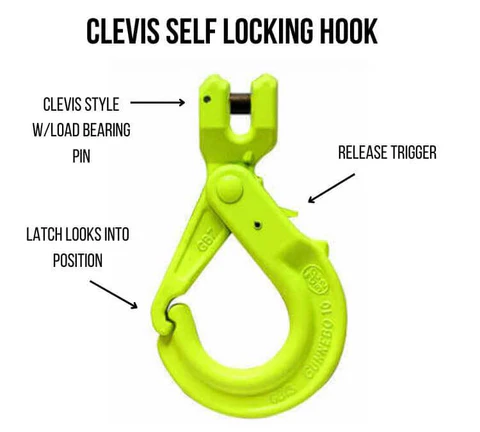In the world of lifting and rigging, your operations are only as safe as your equipment.
Our lifting chains come with different styles of lifting hooks. One of the safest options for lifting tasks is the self-locking hook. It’s engineered to be the safest and most efficient hook for any lifting task.
What is a self-locking hook?
A self-locking hook is a type of lifting hook that locks itself when it touches a load. This means you don’t have to lock it yourself, which makes lifting things safer and easier.
How does it work?
Self-locking hooks have a latch or gate that closes over the opening of the hook, locking it in place. When you put pressure on the latch or gate with the weight of the load, it locks even tighter and is harder to open. This keeps the load from slipping or moving while you’re lifting it – it makes sure the load stays put the whole time you’re lifting it, which helps prevent accidents and injuries.
What Are the Different Styles of Self-Locking Hooks?
There are several styles of self-locking hooks, each designed for different types of lifting tasks. Some common styles include:
- Clevis self-locking hooks: These have a clevis pin and can be connected directly to the lifting chain.
- Swivel self-locking hooks: These allow the hook to rotate while still remaining locked. They will not rotate under load unless they are load bearing.
- Eye self-locking hooks: These have an eye at the end of the hook instead of a clevis pin.
- Load-bearing self-locking hooks: These are designed for heavy-duty lifting tasks. The Swivel Self-Locking Hook with Bearing allows the hook to rotate freely under the load.

Why you should use self-locking hooks
- No Accidental Releases: These hooks are designed to make sure you don’t drop your load and have to start over.
- No Slippage: These hooks are designed to make sure your load doesn’t slip out of the hook and fall on your head.
- No Manual Securing: These hooks are designed to make sure you don’t have to tie your load on with a piece of rope.
- No Safety Violations: These hooks are designed to make sure you don’t get fired for not using the right hooks.

Self-Locking Hooks vs. Traditional Hooks: A Comparison
When it comes to lifting, the type of hook you choose can make a big difference in safety, efficiency, and overall performance. Here, we’ll compare self-locking hooks with traditional hooks to show you the differences and benefits.
Safety Features & Efficiency
- Self-Locking Hooks: These have an automatic locking feature that engages when the load contacts the hook, eliminating the need for you to lock it manually. This greatly reduces the risk of accidentally releasing the load.
- Traditional Hooks: These rely on manual latches or safety pins that you have to lock yourself. This can increase the chance of human error and accidental disengagement, which increases the chances of accidents. They also take longer to lock and unlock, which slows down the lifting process and affects how much you can get done.
Versatility
- Self-Locking Hooks: You can get these in different styles, such as clevis, swivel, eye, and load-bearing hooks. This means you can use them for a wide range of lifting tasks and in different environments.
- Traditional Hooks: You can also get these in different styles, but they may not have the advanced locking features that make self-locking hooks more versatile and durable for more complex lifting situations.
Cost Considerations
- Self-Locking Hooks: These may cost more up front because of the advanced features and durable design, but you’ll make up for it with increased safety, less downtime, and fewer accidents.
- Traditional Hooks: These are generally less expensive to buy at first. However, the potential costs of accidents, inefficiencies, and the need to be constantly vigilant can outweigh the savings over time.
While traditional hooks work for many lifting needs, locking hooks are safer, more efficient, and more versatile. If safety and efficiency are important in your industry, investing in locking hooks is a smart move that will pay off in the long run.
Applications of Self-Locking Hooks
Self-locking hooks are used in a variety of industries because they’re tough and they work. Construction companies use them to lift heavy stuff like steel beams and concrete blocks. They’re safe and they’re precise. Shipping and logistics companies use them to keep cargo from falling off the truck. They’re safe and they’re secure. Manufacturers use them to move big parts around the factory. They’re safe and they’re efficient. Wind and solar companies use them to lift and hold big equipment in place. They’re safe and they’re strong. In all of these applications, self-locking hooks make things safer, easier, and better. That’s why you need them. In short, while regular hooks work fine for some lifting jobs, self-locking hooks are safer, more efficient, and more versatile. If you’re in an industry where safety and efficiency matter, you need self-locking hooks. They’ll pay for themselves in no time.




